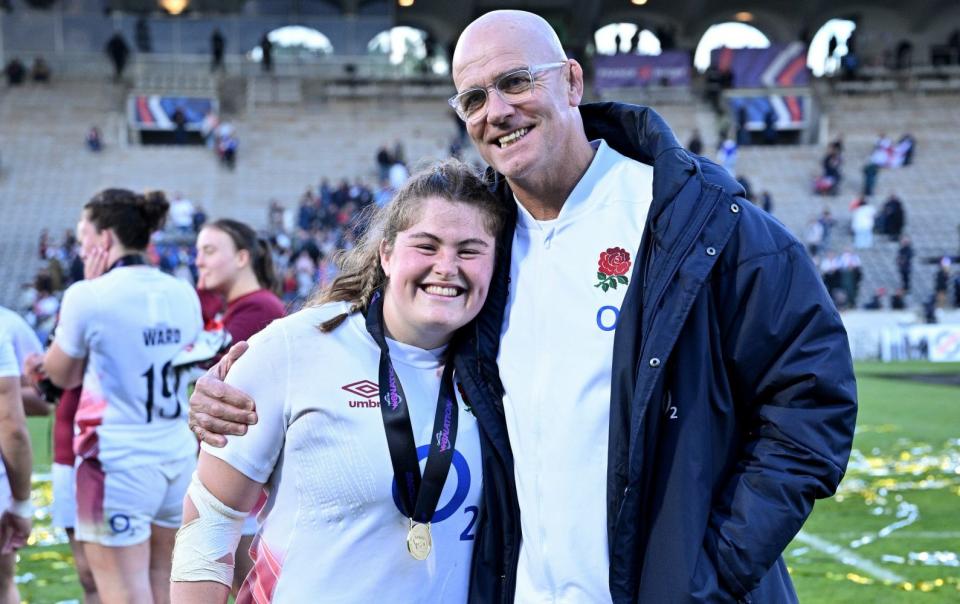Five ways John Mitchell’s triumphant England evolved to claim Six Nations Grand Slam

In the same breath as expressing immense pride after another Grand Slam victory, Marlie Packer declared John Mitchell’s tenure truly under way. It was as if England needed one more win, over a tough opponent spurred on by a partisan crowd, to fully endorse the direction they are travelling under their new head coach.
On the face of it, the 2024 clean sweep was eerily similar to the one they landed under Simon Middleton last season. England scored 44 tries and conceded five this year, finishing with a points difference of +229. Twelve months ago, they scored 45 tries and shipped seven to return a points difference of +223. And yet, this campaign felt distinctive from a tactical standpoint.
Mitchell, who turned 60 last month, has claimed that there is untapped potential in this England squad. His maiden Six Nations in charge delivered on that suggestion and sent the team towards the 2025 World Cup in a convincing manner.

A freshened-up pack…
In matters of selection, coaches cannot afford to be sentimental. Injuries and suspensions require adaptability and succession planning is vital, too. Sarah Beckett’s red card in round one cleared the way for Alex Matthews at No 8 and the latter thrived, signing off with two tries and a player-of-the-match award in Bordeaux.
Dropping Packer to the bench against Scotland gave Mitchell a look at Zoe Aldcroft in the back row with Sadia Kabeya at openside flanker, while Connie Powell and Maddie Feaunati were replacements in every game. Middleton had done a fine job of building experience, which will have been a huge help to Mitchell.
But trusting Morwenna Talling to start over Abbie Ward against France, following the fracture-dislocation that Rosie Galligan suffered to her thumb prior to the Ireland thrashing, was one of a few signs that Mitchell is confident in his squad and in the style he has aimed to impart. Do not forget that Sarah Bern, the world’s best tighthead prop who is among the most dynamic carriers in the game, was sidelined for the entire Six Nations.
England’s pack has played through defences with short, sharp passing. The first two tries on Saturday were fine examples. Hannah Botterman, highly influential as a jackaller and a scrummager, picked at the base of a ruck for number one. She shaped to jam towards the line before sending the ball three metres, across the face of the fringe defence, to Maud Muir.
What a start from England!
Two tries within the opening 15 minutes from the Red Roses 👏👏👏#FRAvENG #SixNations #BBCRugby pic.twitter.com/6n0xRF8agy— BBC Sport (@BBCSport) April 27, 2024
Around seven minutes later, Amy Cokayne stepped up at first receiver and fixed two tacklers before tipping on to a surging Matthews. Deep into the second half, Powell repeated that trick after coming on for Cokayne. From Lucy Packer’s pass, Powell lifted the ball for an arcing Matthews to crash over.
Alex Matthews 🤩🤩 @RedRosesRugby #GuinnessW6N #FRAENG pic.twitter.com/tNS4RkwaZv
— Guinness Women's Six Nations (@Womens6Nations) April 27, 2024
In confrontational games, forwards can be drawn towards collisions. In the final leg of the Grand Slam mission, England did not become blinkered. They continued to move the ball to space.
…with some old tricks
That said, the visitors also found refuge in a prolific staple of the Middleton era; their line-out maul. Louis Deacon, forwards coach since 2021, has drilled this area impressively and two pushovers against France, instigated by Cokayne’s exceptional throwing and the leadership of Aldcroft, steadied England before half-time. Mitchell has clearly not been too proud to ignore the sturdy foundations left for him.
Balanced midfield covering all bases
England’s starting 10-12-13 axis for the opener in Parma was Zoe Harrison, Emily Scarratt and Helena Rowland. On the back of a clunky outing, and injuries to Scarratt and Rowland, that combination changed completely. Holly Aitchison, Tatyana Heard and Megan Jones joined forces for rounds two, three, four and five. And their synergy means they must be considered as the front-line trio moving forward towards WXV in the autumn.
Aitchison is a whippy distributor with an impressive passing range who can open her stride and take the space if tacklers sit off. She nailed all six conversions on Saturday and, despite one or two dodgy strikes, kicked well out of hand as well. Heard combines power and poise, while Jones is a bundle of energy. Her running angles punch holes and create space for others. On the other side of the ball, Jones dictates to opponents with industry and aggression. In an interview for the BBC Rugby Union Weekly podcast, Packer explained that defence coach Sarah Hunter has bestowed a few ‘black panther’ awards on Jones.
An opportunistic try at Stade Chaban-Delmas showcased Jones’s athleticism and anticipation. Following up a driving punt from Aitchison, which split France’s backfield coverage and found grass, Jones stayed connected to Abby Dow on the chase and intercepted a hasty in-field offload from Emilie Boulard.
The interception from Meg Jones 🤌🤩#GuinnessW6N @RedRosesRugby #FRAENG pic.twitter.com/8Nk5P7rYEt
— Guinness Women's Six Nations (@Womens6Nations) April 27, 2024
History tells us that successful teams are galvanised by balance and cohesion in midfield. Mitchell appears to have found these things at the first time of asking.
Aitchison, Heard and Jones are particularly effective when running the trendy shape that teams all around the world deploy; when an inside centre steps up at first-receiver with their No 13 cutting a hard angle and the fly-half circling around into a second wave. Defences have to respect all options, and are often overwhelmed.
Reimagining back-three roles
Another illustration of Mitchell’s self-confidence as a coach has been the ownership that Lou Meadows has taken over the attack as well as the influence that her mentor, Brian Ashton, has been able to assert as a consultant. Clearly, Mitchell is open to new ideas and a stonking Six Nations for England’s back three has been one happy result.
Ellie Kildunne, Dow and Jess Breach bagged 18 tries between them and occupied all three positions on the Championship’s top-scorer podium. And yet, potent finishing was just one facet of their performances. They were obviously encouraged to roam across the pitch to link attacks and overload defences. Swinging around from the right wing, Dow appears to relish that added responsibility. Rewatch Matthews’ second try in Bordeaux and you will see Dow mucking in at the preceding breakdown.
⌚️ Last game of the 2024 Guinness Women's Six Nations, and there was always just enough time for England and Alex Matthews to sneak one more try in before the final whistle 💪#Breitling #DefiningMoment @Breitling pic.twitter.com/pD7iKO0bhf
— Guinness Women's Six Nations (@Womens6Nations) April 27, 2024
Kildunne’s tournament, decorated by nine tries from full-back, saw her lacerate defences with deceptive power and speed. Occasionally, England stationed Matthews in the backfield to enhance their kick-return further, with Kabeya and Feaunati migrating to the wide channels on phase-play, too. As Dow said after the Ireland win, England are intent on thinking outside the box when it comes to attack.
Back in the Hunt
Natasha Hunt’s emotion in her post-match interview with the BBC was entirely understandable. A controversial omission from the 2022 World Cup squad, she has forced her way back into favour and re-established herself. Four consecutive starts at scrum-half reflected her importance. On Saturday, she slammed a long clearance with her first touch, setting an assured tone for England. Later, she hooked another clever kick into space following Cokayne’s line-out steal to peg back France.
Sniping around the fringes and distributing tidily, Hunt has seemingly usurped Packer, who made a courageous, try-saving tackle after arriving from the bench this weekend. At 35, Hunt has invaluable know-how. More valuable to Mitchell, though, has been her palpable desire to prove a point. Along the way, her versatility as a scrum-half has ushered in this new era.
